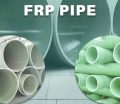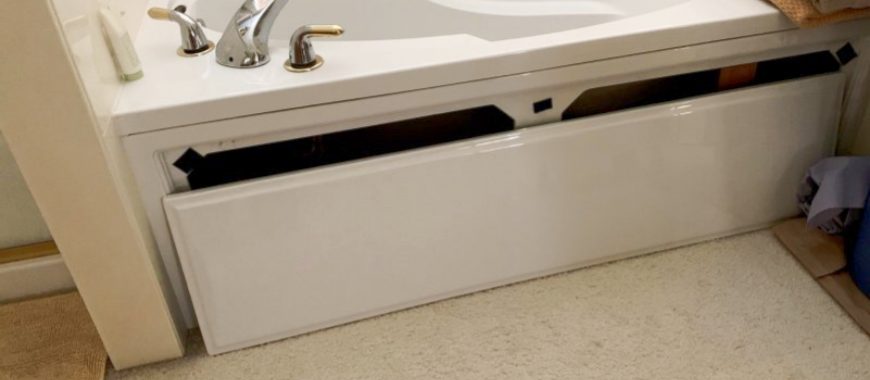
Fiberglass tubs are commonly used due to their affordability and ease of installation. Fiberglass Tub Access Panel is a removable section of the tub enclosure provides easy access to plumbing, pipes for maintenance or repairs. However, they present certain maintenance challenges, especially when plumbing issues arise. Without a fiberglass tub access panel, repairs can become difficult and expensive. Plumbing leaks, valve replacements, and other issues often require access to the pipes beneath or behind the tub. Fiberglass hand lay-up, a process where layers of fiberglass are manually applied to create a durable structure, can be used to reinforce areas around the tub that may be vulnerable to damage during repairs. Installing a fiberglass tub access panel allows for easier maintenance, helping to prevent extensive damage to the tub or surrounding walls. This panel makes it simple to reach plumbing components when leaks occur or when valve replacement is necessary, ensuring timely repairs without the need for major renovations or tub removal.
Why Install an Access Panel in a Fiberglass Tub?
Fiberglass tubs are popular, but they can present maintenance challenges. Leaks, poor plumbing design, and structural issues are common problems. Without a fiberglass tub access panel, addressing these issues often means cutting into the tub or walls. This can lead to costly and invasive repairs, especially when plumbing components are hidden behind or under the tub. This is particularly relevant for small fiberglass tubs, where limited space can make access even more difficult.
Easy Access for Future Repairs
A fiberglass tub access panel provides direct access to plumbing fixtures, allowing for quick repairs when needed. Whether it’s a leak or a valve replacement, an access panel simplifies the process.
Minimal Damage to the Tub
Installing a fiberglass tub access panel prevents the need to remove or damage the tub. The panel allows repairs to be made without cutting into the tub or surrounding structures, preserving the integrity of your bathroom.
Cost-Effective Solution
A fiberglass tub access panel is a cost-effective solution for homeowners. It eliminates the need for expensive renovations or the removal of the entire tub, saving both time and money.
Long-Term Maintenance Benefits
For both rental and residential properties, installing a fiberglass tub access panel ensures long-term maintenance is easier and less costly. It allows for regular inspection and repairs without the hassle of damaging the tub or walls. This can be especially beneficial for landlords who need to make quick repairs between tenants.
Size of Fiberglass Tub Access Panel
The size of a Fiberglass Tub Access Panel can vary depending on the specific design and the requirements of the plumbing or mechanical systems it needs to provide access to. Generally, these panels range from 12×12 inches to 20×30 inches, but custom sizes may also be available or required.
- Standard Sizes: Commonly, manufacturers produce panels in standard dimensions like 12×12 inches, 14×14 inches, or 16×16 inches, as these are sufficient for most residential plumbing setups.
- Custom Sizes: In some cases, especially for larger or more complex tub installations, access panels might need to be custom-made to fit the specific dimensions of the space or to provide adequate access to all necessary components.
- Depth Considerations: While the panel’s surface area is crucial, its depth or the space behind it should also accommodate the pipes or fixtures it covers.
- Code and Aesthetic: The size should also comply with local building codes and blend aesthetically with the tub and surrounding decor.
When choosing or designing an access panel, it’s essential to ensure it is large enough for maintenance tasks but not so large that it compromises the structure or appearance of the tub enclosure.
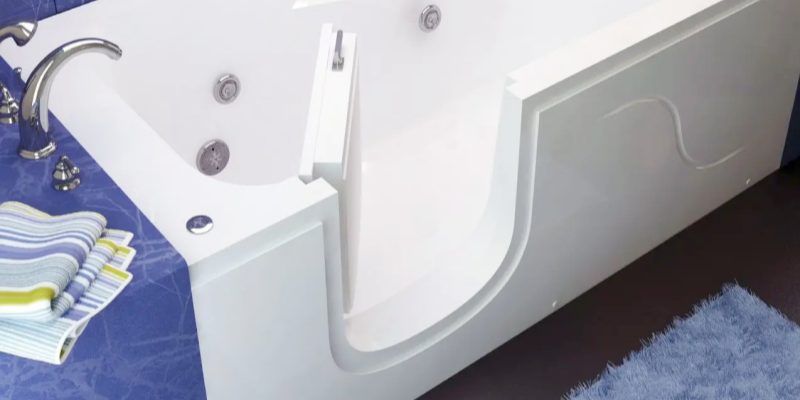
Fiberglass Tub Access Panel vs Tile Tub Access Panel
| Feature | Fiberglass Tub Access Panel | Tile Tub Access Panel |
|---|---|---|
| Material | Made from fiberglass or acrylic materials that are lightweight, durable, and designed to match the tub’s finish. | Constructed using ceramic, porcelain, or stone tiles that align with the surrounding wall or floor tiles. |
| Appearance and Aesthetics | Fiberglass panels blend seamlessly with fiberglass or acrylic tubs. They are often pre-finished and smooth, matching the tub’s design and color. | Tile panels are highly customizable and visually integrate into tiled walls or floors. They provide a luxurious, cohesive look, especially in high-end bathrooms. |
| Durability | Fiberglass panels are durable and resist water damage but may scratch or fade over time, particularly with heavy use. | Tile panels are extremely durable, resistant to wear, scratches, and fading. Properly maintained tiles can last for decades. |
| Installation | Fiberglass access panels are easier to install, often requiring a simple cutout and adhesive or magnetic fasteners for secure placement. No specialized skills are typically needed. | Tile access panels require professional installation to ensure proper alignment with surrounding tiles. They may involve precise cutting and mounting techniques for a seamless finish. |
| Maintenance Access | Fiberglass panels are easy to remove, often with magnetic or snap-on mechanisms. They allow quick and straightforward access to plumbing or mechanical systems. | Tile panels may have a hinged design or require careful removal of specific tiles to access plumbing. While functional, this process can be more time-consuming. |
| Water Resistance | Fiberglass is naturally water-resistant, as it is a non-porous material. This makes it ideal for high-moisture areas like bathrooms. | Tile panels are also water-resistant, but the grout lines between tiles can absorb moisture if not properly sealed. Regular grout maintenance is essential. |
| Customization | Limited customization options, as they are typically pre-made in standard sizes and finishes designed to match fiberglass or acrylic tubs. | Highly customizable in size, shape, and design, allowing seamless integration with existing tile patterns and styles. |
| Cost | More affordable, both in terms of materials and labor. Fiberglass panels are widely available and generally budget-friendly. | More expensive due to the cost of tiles, professional installation, and the time required to match the existing tile layout. |
| Repairs and Replacement | Fiberglass panels are easily replaced if damaged. Most replacements involve buying a new panel and snapping it into place. | Tile panels are harder to repair, as damaged tiles may require retiling the area. Matching tiles may be challenging if the originals are discontinued. |
| Support Requirements | Fiberglass panels are lightweight and don’t need much additional structural support. | Tile panels may require a more robust backing, like cement board, to ensure stability and prevent cracking over time. |
Advantages of Fiberglass Tub Access Panels
- Ease of Installation: Fiberglass panels can be installed quickly and removed with minimal effort, making them ideal for DIY projects or quick fixes.
- Cost-Effective: Affordable materials and labor make this option accessible for most budgets.
- Water Resistance: The material is naturally waterproof and resists mold and mildew.
Advantages of Tile Tub Access Panels
- High-End Look: Tile panels provide a seamless, integrated design that enhances the aesthetic appeal of a tiled bathroom.
- Durability: With proper installation and maintenance, tile panels can outlast fiberglass, resisting scratches and fading.
- Customizable Design: Perfect for matching existing tiles, they allow endless design possibilities for a cohesive look.
When to Choose Fiberglass Access Panels
- If you have a fiberglass or acrylic tub and prioritize affordability, simplicity, and quick installation.
- In situations where easy access for maintenance is critical, such as frequent repairs or inspections.
When to Choose Tile Access Panels
- For bathrooms with tiled walls or floors where aesthetics and design integration are a priority.
- If you’re willing to invest in a durable, long-term solution that enhances the overall appearance of the bathroom.
The choice between fiberglass and tile access panels ultimately depends on your bathroom’s design, budget, and functional needs. Fiberglass is practical and cost-effective, while tile offers unmatched aesthetic appeal and durability for high-end spaces.
Fiberglass Reinforced Plastic Decking Safety Tips
Fiberglass Tub Access Panel Replacement
When to Replace a Fiberglass Tub Access Panel
A fiberglass tub access panel may need to be replaced if there are visible signs of wear or damage. Deterioration, cracks, or leaks around the panel indicate that replacement is necessary. Over time, exposure to moisture can weaken the panel, causing it to lose its seal. If these issues are not addressed promptly, water damage and mold may occur behind the tub. Regular inspection of the panel helps to identify potential problems before they escalate.
Steps for Replacing a Fiberglass Tub Access Panel
Removing the Old Panel
Carefully remove the old fiberglass tub access panel by cutting around the edges using a utility knife. Be cautious not to damage the surrounding fiberglass or plumbing.
Inspecting and Repairing Underlying Damage
Once the old panel is removed, inspect the area for any underlying damage. If water damage or mold is found, address these issues before installing the new panel. This may include replacing wet insulation or fixing any leaks.
Installing the New Panel
Select a new fiberglass tub access panel that fits the existing opening. Ensure it is properly aligned before securing it in place with an adhesive that is compatible with fiberglass. Use a caulking gun to seal the edges, ensuring a watertight fit.
Materials Needed for Replacement
- Fiberglass-compatible panel kits: Choose a kit designed for fiberglass tubs to ensure a proper fit and seal.
- Utility knife: A sharp blade is necessary for cutting through the old adhesive and removing the panel.
- Adhesive and caulking gun: Use a fiberglass-safe adhesive and caulk to secure the new panel and create a watertight seal.
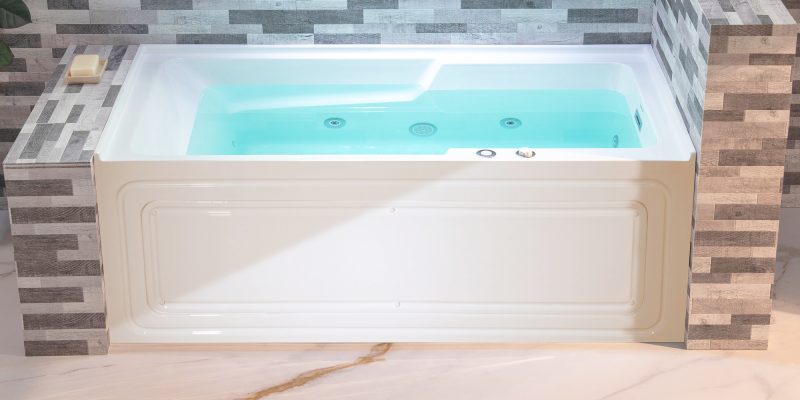
Factors influencing frp pipe density in engineering projects
Fiberglass Tub Access Panel Installation
Steps for Installing a Fiberglass Tub Access Panel
Identify the Location of Plumbing Fixtures
Before installation, locate the plumbing fixtures, such as tub valves, drain pipes, or water supply lines. This ensures the access panel is positioned correctly.
Measure and Mark the Area
Once the plumbing location is identified, carefully measure the area where the fiberglass tub access panel will be installed. Mark the dimensions on the fiberglass surface using a pencil or marker for accurate cutting.
Use a Cutting Tool Designed for Fiberglass
Using a saw specifically designed for fiberglass, cut along the marked area. Take your time to avoid damaging the tub surrounding fiberglass or creating an uneven opening.
Install the Panel and Ensure a Water-Tight Fit
After cutting, insert the fiberglass tub access panel into the opening. Apply a fiberglass-compatible sealant around the edges to create a water-tight fit. This prevents water from seeping into the surrounding walls or floor. Ensure the panel is securely attached to avoid future issues.
Tools and Materials Needed
- Panel Kit: A pre-made fiberglass tub access panel kit ensures the right size and materials for your tub.
- Fiberglass Saw: A specialized saw is needed to cut through the fiberglass material cleanly.
- Sealant: Use a fiberglass-safe sealant to create a water-tight barrier around the panel.
- Adhesive Tape: Adhesive tape can help hold the panel in place while the sealant cures.
- Safety bar: If installing a safety bar for fiberglass tubs, ensure that the area where the bar is to be mounted is properly reinforced to support the weight and prevent damage to the tub’s surface.
Safety Precautions
When installing a fiberglass tub access panel, always prioritize safety. Wear gloves and a mask to protect yourself from fiberglass dust, which can be irritating to the skin and lungs. Take care to cut slowly and steadily to avoid damaging the tub or surrounding plumbing. In addition, when considering how to protect fiberglass tubs during construction, ensure the tub is covered with a protective layer, such as plastic sheeting or foam padding, to prevent scratches, dents, and other potential damage that can occur during installation.
By following these steps and using the correct tools, installing a fiberglass tub access panel can be a straightforward and effective way to improve access to essential plumbing.
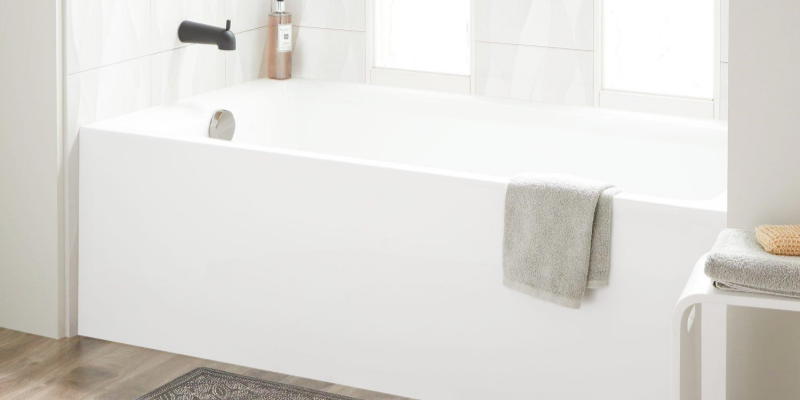
DIY vs. Professional Installation: Which is Better for a Fiberglass Tub Access Panel?
When deciding whether to install a fiberglass tub access panel yourself or hire a professional, there are important factors to consider. Each option offers unique benefits, and the decision depends on your skills, budget, and confidence in handling plumbing and structural tasks.
| Installation Method | Pros | Cons |
|---|---|---|
| DIY Installation | 1.Cost-effective 2.Suitable for those with basic handyman skills 3.Flexible scheduling | 1.Risk of improper installation 2.May affect tub’s structural integrity if not done correctly |
| Professional Installation | 1.Ensures proper sealing and plumbing 2.Guarantees work meets building codes 3.Avoids costly errors | 1.Higher upfront cost 2.Less scheduling flexibility 3.May require waiting for availability |
Pros of DIY Installation
Cost-Effective
DIY installation of a fiberglass tub access panel is significantly cheaper than hiring a professional. You’ll save on labor costs by doing the work yourself, making it an attractive option for budget-conscious homeowners.
Suitable for Those with Basic Handyman Skills
If you have some experience with home repairs, installing a fiberglass tub access panel is a relatively simple task. With the right tools and materials, most homeowners can complete this job themselves.
Flexibility in Scheduling
Doing it yourself allows you to work on your own time. There’s no need to coordinate with a contractor, and you can complete the installation at your own pace.
Pros of Hiring a Professional
Ensures the Structural Integrity of the Tub
A professional installer will ensure that the fiberglass tub access panel is installed without compromising the tub’s structure. They have the expertise to avoid any damage to the surrounding plumbing or fiberglass.
Expertise in Plumbing and Proper Sealing Techniques
Proper sealing is essential to prevent leaks. A professional has the experience and knowledge to correctly install the fiberglass tub access panel, ensuring that it is watertight and securely fitted. This expertise can be especially important in complex installations.
Guarantees Work is Done According to Local Building Codes
Professionals are familiar with local building codes and will ensure that the installation of the fiberglass tub access panel meets all necessary regulations. This can help avoid potential issues if you decide to sell your home or if future inspections are required.
Essential Uses of Filament Wound Fiberglass Tubing in Industry
Maintenance and Care After Installing a Fiberglass Tub Access Panel
Proper maintenance is essential to ensure the long-term functionality of your fiberglass tub access panel. Regular inspections, careful cleaning, and preventive measures will keep it in excellent condition and prevent damage to the tub and surrounding areas.
Preventing Future Damage
To avoid serious issues, regularly inspect the fiberglass tub access panel for any leaks or cracks. These inspections should be done every few months to catch any potential problems early. If any signs of wear are visible, such as small cracks or weakened seals, immediate action should be taken to prevent water damage to the plumbing or surrounding materials. Addressing minor issues promptly ensures the panel remains fully functional and extends its lifespan.
Cleaning and Maintenance
Maintaining the cleanliness of the fiberglass tub access panel is crucial for avoiding long-term damage. Use only fiberglass-safe cleaning products, as harsh chemicals or abrasive cleaners can scratch or degrade the surface. Gentle cleaners like Soft Scrub or non-abrasive solutions designed for fiberglass are ideal. Cleaning the panel weekly or after heavy use helps to prevent soap scum and mineral deposits from accumulating, which could impact the panel’s effectiveness and appearance.
Tips for Longevity
- Proper Ventilation:Ensuring good ventilation in your bathroom is vital for preventing moisture buildup around the fiberglass tub access panel. High moisture levels can lead to mold and deterioration of seals. Keep an exhaust fan running during and after showers to help reduce humidity and extend the life of both the panel and surrounding surfaces.
- Periodic Resealing of Edges:Over time, the sealant around the fiberglass tub access panel can wear down, especially due to constant exposure to moisture. To maintain a watertight seal, inspect the edges of the panel annually. If the sealant appears worn or cracked, apply fresh silicone or another fiberglass-safe sealant to prevent leaks.
- Quick Action on Visible Wear and Tear:If you notice any visible wear on the fiberglass tub access panel, such as small cracks or loose fittings, it’s essential to act quickly. Immediate repairs can prevent more significant issues like water damage or mold growth. Quick fixes for minor wear can extend the life of the panel and save on more expensive repairs later.
Steps of Repairing Fiberglass Tub Access Panel
Repairing a fiberglass tub access panel involves addressing cracks, chips, or other damage while restoring its appearance and functionality. Below are the detailed steps:
Step 1: Assess the Damage
- Inspect the access panel for cracks, holes, scratches, or discoloration.
- Determine whether the damage is superficial (e.g., scratches or minor chips) or structural (e.g., cracks or holes).
Step 2: Gather Tools and Materials
- Tools: Sandpaper (various grits), utility knife, putty knife, masking tape, and a soft cloth.
- Materials: Fiberglass repair kit (resin, hardener, and fiberglass cloth), gel coat repair paste, color-matching paint, primer (if needed), and polish or wax.
Step 3: Clean the Panel
- Wash the panel thoroughly with warm water and mild dish soap to remove dirt, grease, and grime.
- Rinse and dry the panel completely before proceeding.
Step 4: Prepare the Damaged Area
- For scratches: Sand the area lightly with fine-grit sandpaper to smooth the surface.
- For cracks or holes:
- Enlarge small cracks slightly with a utility knife to ensure the repair material adheres properly.
- Sand around the damaged area with medium-grit sandpaper to roughen the surface, which helps the fiberglass resin bond effectively.
Step 5: Apply Fiberglass Repair Kit
- Mix the Resin and Hardener: Follow the instructions in the repair kit to mix the resin and hardener in the correct proportions.
- Apply Fiberglass Cloth (if needed): For larger cracks or holes, cut a piece of fiberglass cloth to fit over the damage and saturate it with the resin mixture.
- Fill the Damage: Spread the resin mixture or gel coat repair paste over the damaged area using a putty knife, ensuring it is slightly higher than the surrounding surface.
- Let the repair cure as per the manufacturer’s instructions, usually several hours.
Step 6: Sand and Smooth
- Once cured, sand the repaired area using progressively finer grit sandpaper (start with medium grit and finish with fine grit) until it is flush with the surrounding surface.
- Be careful not to sand too aggressively, as this can damage the repair.
Step 7: Prime and Paint (Optional)
- If the access panel needs to match a specific color, apply a primer and then a color-matched paint over the repaired area.
- Let the paint dry completely before proceeding to the final step.
Step 8: Polish and Finish
- Use a polishing compound or wax to restore the panel’s shine and protect the surface.
- Buff the area with a soft cloth to achieve a smooth, glossy finish.
Step 9: Reinstall the Access Panel
- Reattach the repaired access panel to the tub enclosure, ensuring it fits securely and aligns properly with the opening.
Tips for Success
- Always work in a well-ventilated area when using fiberglass resin or gel coat, as the fumes can be harmful.
- Wear gloves and safety glasses to protect your skin and eyes during the repair process.
- If the damage is extensive or you are unsure about the repair process, consider consulting a professional.
By following these steps, you can effectively repair a fiberglass tub access panel and restore its functionality and appearance.
FAQs about Fiberglass Tub Access Panel
Yes, bathtubs, especially those made of fiberglass, benefit from having an access panel. A fiberglass tub access panel provides easy access to plumbing components such as water supply lines, drain pipes, and valves. Without an access panel, repairs become more invasive, often requiring the removal of tiles or parts of the wall, which can be costly and time-consuming. The panel simplifies future maintenance by allowing quick access to the plumbing system without damaging the bathtub or surrounding area. It’s particularly useful for fixing leaks or replacing worn-out valves, ensuring the long-term functionality of your tub.
Yes, you can install a grab bar in a fiberglass tub, but it requires careful consideration. Fiberglass is not as sturdy as materials like cast iron or acrylic, so it’s important to install the grab bar correctly to avoid damaging the tub. You’ll need to ensure that the grab bar is securely anchored to the studs behind the fiberglass wall rather than just into the fiberglass itself. Special mounting hardware designed for fiberglass or hollow walls is also recommended. Installing a grab bar can improve safety, particularly for individuals with mobility challenges, but it’s crucial to ensure a professional, secure installation.
Do not use abrasive cleaners, scouring pads, or steel wool on a fiberglass tub, as these can scratch the surface and damage the protective gel coat. Harsh chemicals like undiluted bleach, ammonia, or highly acidic solutions should also be avoided because they can discolor or weaken the fiberglass over time. Additionally, avoid placing heavy or sharp objects directly on the tub as these can lead to chips or cracks. Stick to gentle, pH-balanced cleaners and soft cleaning tools, such as a microfiber cloth or non-abrasive sponge, to ensure the tub remains in good condition. Regular maintenance with mild soap and water can prevent the buildup of grime, reducing the need for harsher cleaning methods.
A fiberglass bathtub typically lasts between 10 to 15 years with proper care and maintenance. Over time, the surface may develop scratches, discoloration, or even small cracks, which can reduce its functional lifespan. Factors such as frequency of use, cleaning practices, and the quality of the tub’s installation can all impact how long it lasts. To extend its life, avoid using harsh chemicals or abrasive tools, and address any minor issues, such as chips or cracks, promptly before they worsen. In comparison to materials like acrylic or porcelain, fiberglass may have a shorter lifespan, but its affordability and ease of installation make it a popular choice for many homeowners.
Yes, Dawn dish soap is an excellent option for cleaning fiberglass tubs. Its gentle formula effectively removes soap scum, grease, and light stains without damaging the tub’s surface. To clean, dilute a small amount of Dawn in warm water and use a soft sponge or microfiber cloth to scrub the tub. This method is especially effective for regular maintenance and can prevent the buildup of grime over time. Dawn dish soap is also safe to use on fiberglass because it doesn’t contain abrasive particles or harsh chemicals that might scratch or discolor the surface. After cleaning, rinse thoroughly with water to remove any soapy residue and dry the tub with a clean towel to preserve its shine.
Using bleach on a fiberglass tub is not recommended, as it can damage the surface and cause discoloration over time. Bleach is a strong chemical that may erode the protective gel coat on fiberglass, leading to a dull finish or even structural weakening if used excessively. In some cases, bleach can also cause the tub to turn yellow, especially if it is left on the surface for too long or not properly diluted. If you need to disinfect your fiberglass tub, consider using a gentler alternative, such as a diluted vinegar solution or a commercial cleaner designed specifically for fiberglass. Always rinse thoroughly to prevent chemical buildup and maintain the tub’s appearance.
Fiberglass tubs are more prone to cracking compared to other materials like acrylic or porcelain. This is because fiberglass is lightweight and somewhat flexible, making it more vulnerable to damage from heavy impacts, excessive weight, or sharp objects. Over time, the material can also weaken due to repeated stress, improper installation, or exposure to harsh chemicals. To prevent cracking, ensure the tub is installed with proper support, avoid dropping heavy items onto the surface, and clean it with gentle, non-abrasive products. Addressing minor chips or cracks promptly can also help prevent them from spreading and compromising the tub’s structural integrity.
The best way to clean a fiberglass tub is to use a mild, non-abrasive cleaner, such as dish soap, baking soda, or a commercial fiberglass-safe product. Mix the cleaner with warm water and use a soft sponge, microfiber cloth, or a nylon brush to gently scrub the surface. For stubborn stains, a paste of baking soda and water can be applied and left to sit for a few minutes before rinsing. Avoid harsh chemicals and abrasive tools that can damage the finish. Regular cleaning after each use can prevent the buildup of soap scum and grime, keeping your fiberglass tub looking clean and shiny.
Acrylic tubs are generally better than fiberglass tubs in terms of durability, heat retention, and overall performance. Acrylic is thicker and more resistant to scratches, chips, and discoloration. It also retains heat longer, making it ideal for baths. Fiberglass, on the other hand, is more affordable and lightweight, making it a practical choice for budget-conscious homeowners or for situations where ease of installation is a priority. However, fiberglass is more prone to wear and tear over time, including cracking and surface dulling. If longevity and durability are your main concerns, acrylic is the superior choice, though fiberglass is an excellent option for short-term use or lower budgets.
Yes, using bleach on fiberglass can cause yellowing over time. The chemical reaction between bleach and the gel coat or resin in the fiberglass can lead to discoloration, particularly if the bleach is left on the surface for too long or not rinsed off properly. Additionally, frequent use of bleach can weaken the material, making it more susceptible to staining and damage. To avoid yellowing, opt for gentler cleaning alternatives like diluted vinegar or a fiberglass-safe cleaning product. Regular maintenance with mild soap and water can also prevent the need for stronger chemicals.
Magic Erasers can be used cautiously on fiberglass tubs but should be handled with care. While they are effective at removing stubborn stains and soap scum, they have a mildly abrasive texture that can cause micro-scratches on the fiberglass surface if used with too much pressure. To avoid damage, test the Magic Eraser on a small, inconspicuous area first and use light, gentle strokes when cleaning. For routine maintenance, softer cleaning tools like microfiber cloths or non-abrasive sponges are a safer choice to protect the tub’s finish.
Yes, fiberglass tubs are susceptible to scratches because of their softer surface. This makes it important to avoid using abrasive tools, such as steel wool or scouring pads, as well as harsh chemical cleaners that can further erode the protective gel coat. Even dragging sharp or heavy objects across the tub can leave noticeable marks. To minimize scratches, always use soft cleaning tools, and clean regularly to prevent the buildup of grime, which can cause micro-abrasions when scrubbed. For existing scratches, a fiberglass repair kit or polish can help restore the surface to its original condition.
To restore an old fiberglass tub, start by thoroughly cleaning it with a mild cleaner to remove soap scum, stains, and grime. For tougher stains, use baking soda or a commercial fiberglass cleaner. After cleaning, polish the surface with a fiberglass restorer or car wax to bring back its shine and reduce visible scratches. For more significant wear, such as deep scratches or discoloration, consider using a refinishing kit or hiring a professional to reglaze the tub. Regular waxing can help maintain the tub’s appearance and keep it looking like new.
Yes, waxing a fiberglass tub can be beneficial. Applying a thin layer of car wax or fiberglass polish helps protect the surface, enhance shine, and make cleaning easier by creating a water-repellent barrier. However, avoid waxing areas where slip-resistance is needed, such as the bottom of the tub. Waxing should be done sparingly, ideally every few months, and only after the tub has been thoroughly cleaned and dried. This will help preserve the tub’s finish and prevent it from looking dull or worn.
No, Comet and other abrasive powder cleaners are not recommended for fiberglass tubs. These products can scratch the surface and wear down the protective gel coat, leading to a dull and damaged finish. Instead, use a non-abrasive cleaner, such as dish soap, baking soda, or a commercial fiberglass-safe product, along with a soft sponge or cloth. These alternatives effectively clean the tub without causing damage and are better suited for maintaining the integrity of the fiberglass.
Yes, fiberglass tubs require proper support to ensure they remain stable and avoid cracking. They are lightweight and flexible, so without adequate support, they may flex or sag over time, leading to damage. During installation, a solid, level base is crucial. This is often achieved with a mortar bed or foam support, which distributes weight evenly and prevents the tub from shifting or cracking under pressure. Ensuring the tub is well-supported is key to its longevity and structural integrity.

As the editor of GangLong Fiberglass, I have years of experience and in-depth research, focusing on cable tray products, fiberglass solutions, and grille systems. I incorporate years of industry insights and practical experience into every content, committed to promoting the progress of the industry. At GangLong Fiberglass, my commitment is reflected in every product, from innovative cable trays to durable fiberglass solutions and sturdy grille systems. As an authoritative voice in the industry, my goal is to provide valuable information to professionals and businesses and promote forward-looking solutions.

